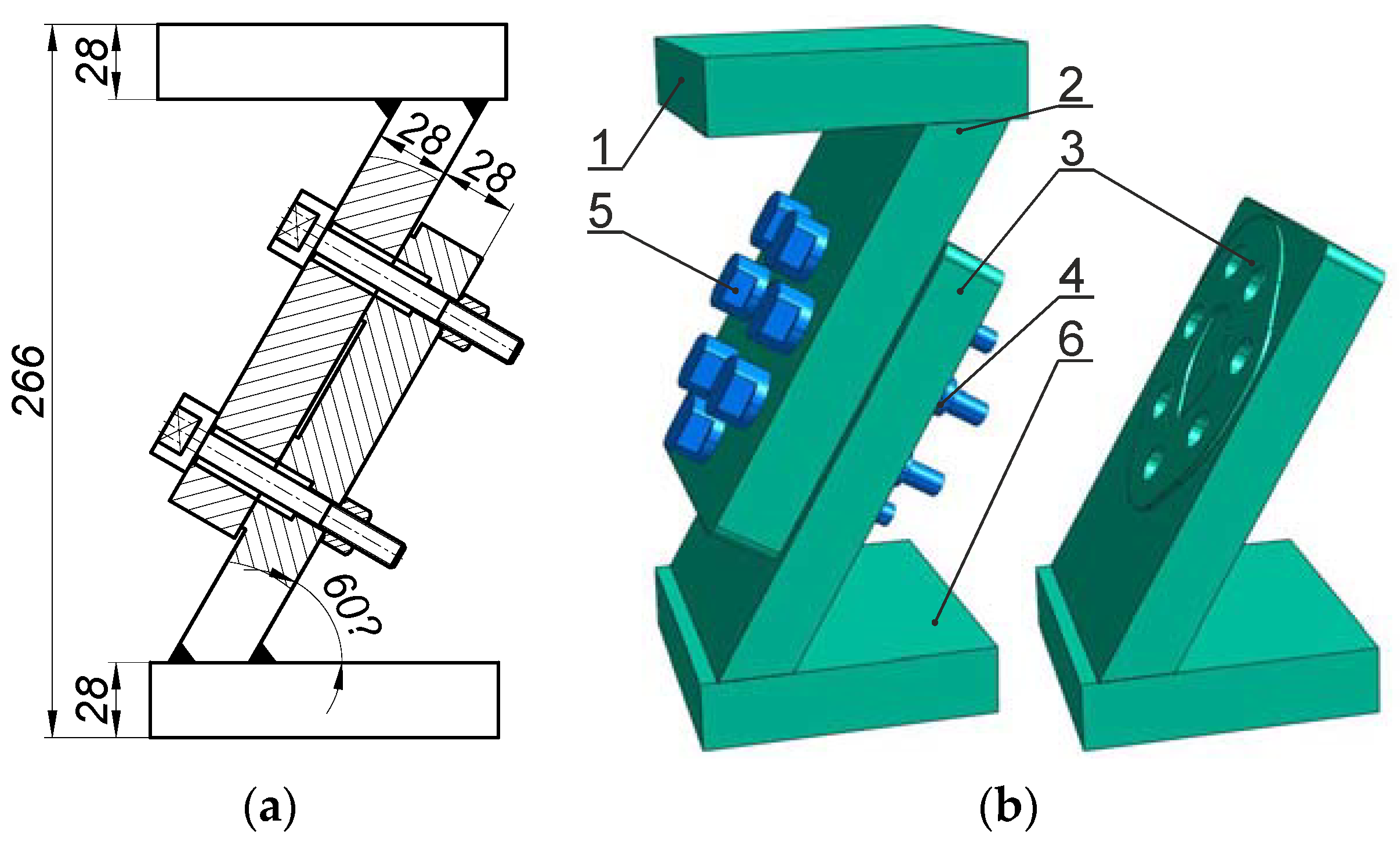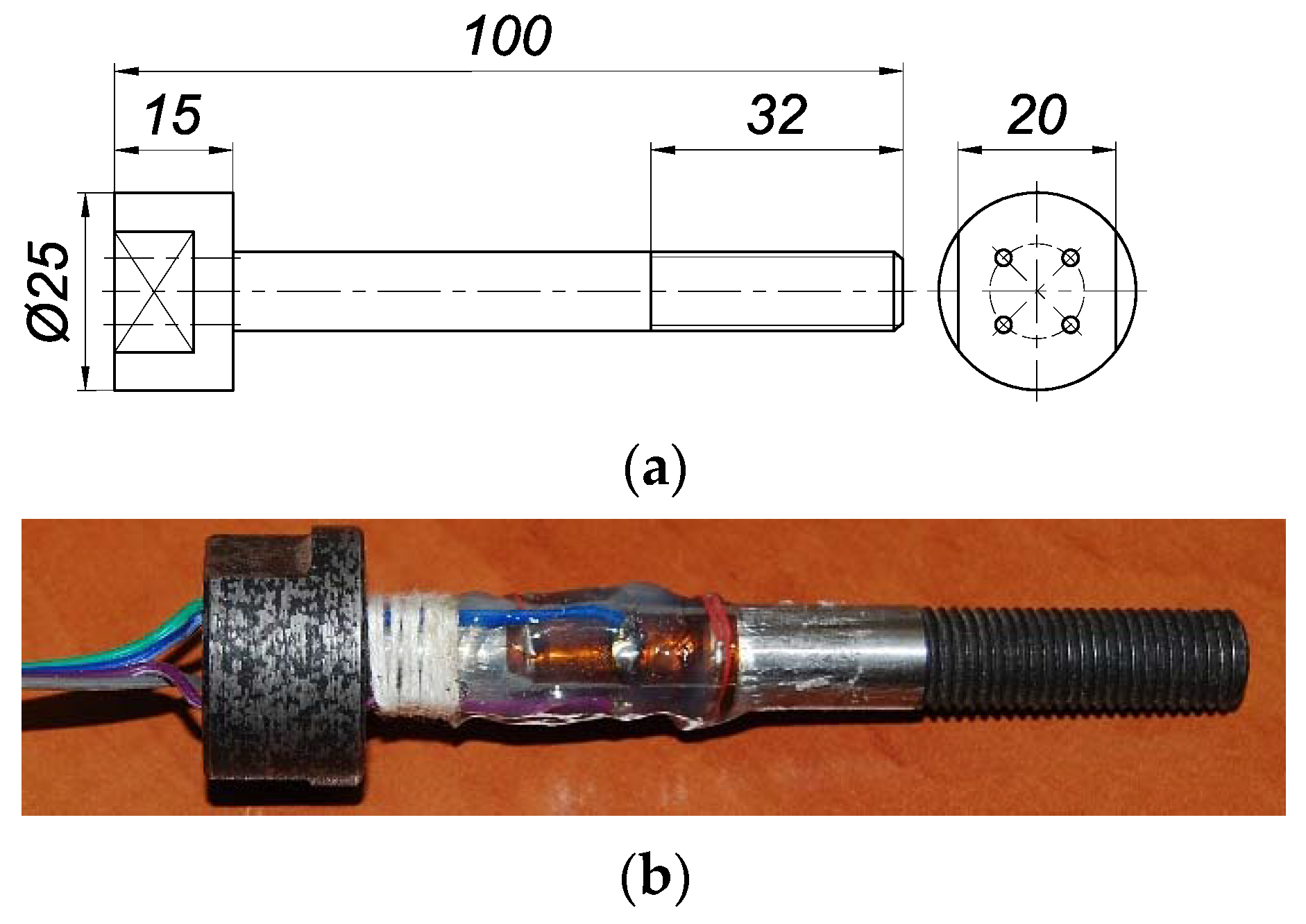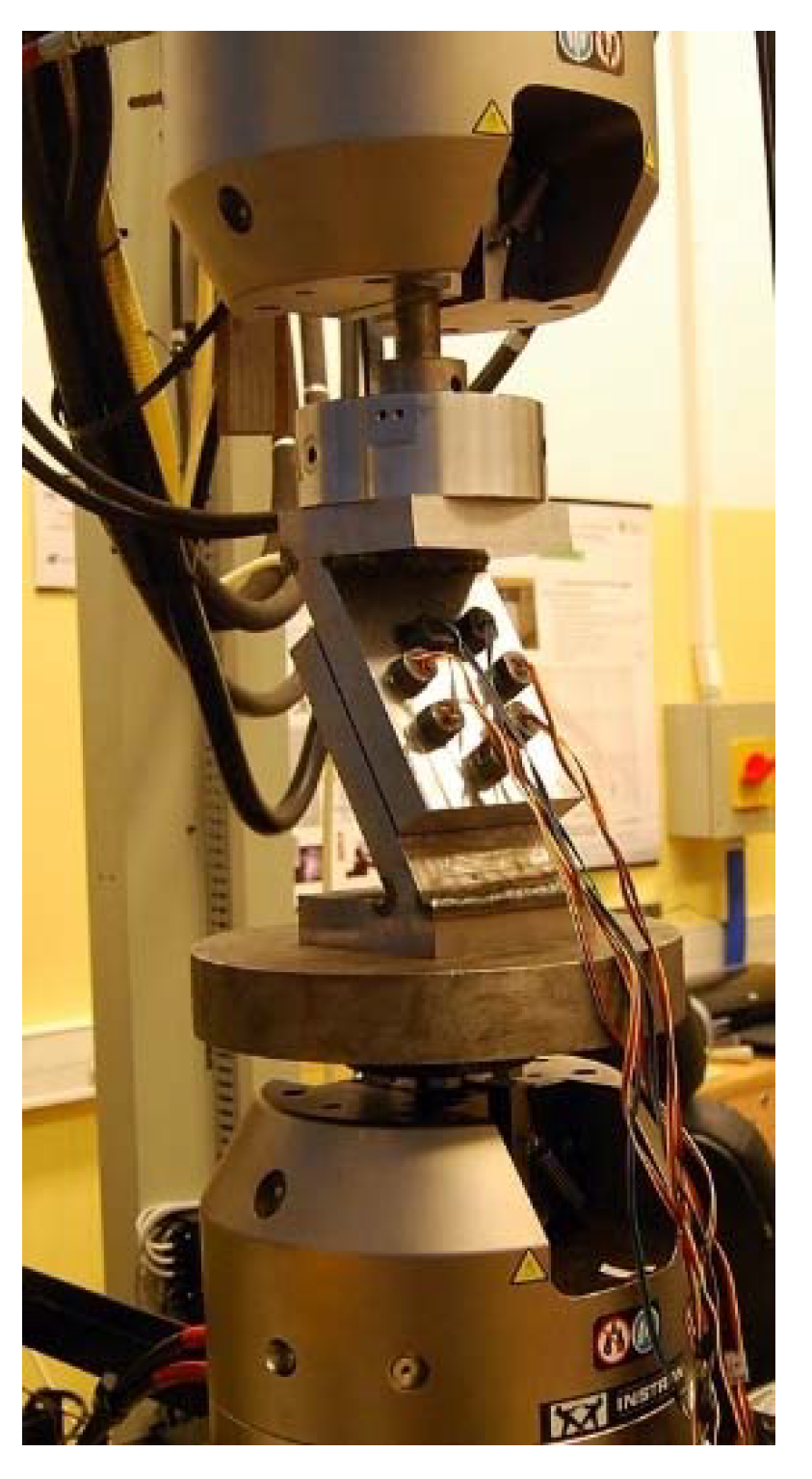Experimental Studies of an Asymmetric Multi-Bolted Connection under Monotonic Loads
Abstract
:1. Introduction
2. Bolted Connection and Bolt Calibration
3. Main Research Stand and Research Procedure
4. Results and Discussion
- The bolt forces values varied upon the application of exploitation loads to a multi-bolted connection;
- The variability in the bolt forces in the exploitation state of the multi-bolted connection depended on the bolt position in relation to the direction of the exploitation loads;
- In the exploitation state, the bolt forces generally decreased. The exceptions were the forces in bolts No. 3 and 6, i.e., those lying near the straight line parallel to the connection base and passing through the centre of gravity of the cross-sectional areas of all bolts (point C in Figure 5);
- In the unloading stage of the multi-bolted connection, the bolt forces generally decreased. The exceptions were the forces in bolts No. 2 and 7, i.e., those lying directly below the straight line parallel to the connection base and passing through the centre of gravity of the cross-sectional areas of all bolts (point C in Figure 5).
- The Z1 index enables a relative evaluation of the changes in bolt forces during loading of the multi-bolted connection;
- The Z2 index enables a relative evaluation of the changes in bolt forces during unloading of the multi-bolted connection;
- The Z3 index enables a relative evaluation of the changes in bolt forces after the loading and unloading process of the multi-bolted connection in reference to the initial values of the preload in the bolts.
- Under the load of the multi-bolted connection with the Fe force of 40 kN, the bolt forces decreased by 0.3%;
- During the unloading of the connection, the bolt forces decreased by 0.28% in relation to their values corresponding to the maximum value of the exploitation load;
- The forces in the bolts after unloading the connection decreased by 0.3% compared to the initial values of their preload.
5. Conclusions
Author Contributions
Funding
Institutional Review Board Statement
Informed Consent Statement
Data Availability Statement
Conflicts of Interest
References
- Ascione, F. A preliminary numerical and experimental investigation on the shear stress distribution on multi-row bolted FRP joints. Mech. Res. Commun. 2010, 37, 164–168. [Google Scholar] [CrossRef]
- Fallahnezhad, K.; Steele, A.; Oskouei, R.H. Failure mode analysis of aluminium alloy 2024-T3 in double-lap bolted joints with single and double fasteners; A numerical and experimental study. Materials 2015, 8, 3195–3209. [Google Scholar] [CrossRef] [Green Version]
- Blachowski, B.; Swiercz, A.; Gutkiewicz, P.; Szelążek, J.; Gutkowski, W. Structural damage detectability using modal and ultrasonic approaches. Measurement 2016, 85, 210–221. [Google Scholar] [CrossRef]
- Jaszak, P. Prediction of the durability of a gasket operating in a bolted-flange-joint subjected to cyclic bending. Eng. Fail. Anal. 2021, 120, 105027. [Google Scholar] [CrossRef]
- Grzejda, R. Finite element modeling of the contact of elements preloaded with a bolt and externally loaded with any force. J. Comput. Appl. Math. 2021, 393, 113534. [Google Scholar] [CrossRef]
- Grzejda, R.; Parus, A. Experimental studies of the process of tightening an asymmetric multi-bolted connection. IEEE Access 2021, 9, 47372–47379. [Google Scholar] [CrossRef]
- Bao, W.; Jiang, J.; Yu, Z.; Zhou, X. Mechanical behavior of high-strength bolts in T-stubs based on moment distribution. Eng. Struct. 2019, 196, 109334. [Google Scholar] [CrossRef]
- Tartaglia, R.; D’Aniello, M.; Zimbru, M. Experimental and numerical study on the T-Stub behaviour with preloaded bolts under large deformations. Structures 2020, 27, 2137–2155. [Google Scholar] [CrossRef]
- Efthymiou, E. Numerical and experimental investigation of a reference aluminium bolted joint. Jordan J. Civ. Eng. 2008, 2, 307–323. [Google Scholar]
- De Matteis, G.; Brescia, M.; Formisano, A.; Mazzolani, F.M. Behaviour of welded aluminium T-stub joints under monotonic loading. Comput. Struct. 2009, 87, 990–1002. [Google Scholar] [CrossRef]
- Šliseris, J.; Gaile, L.; Pakrastiņš, L. Deformation process numerical analysis of T-stub flanges with pre-loaded bolts. Procedia Eng. 2017, 172, 1115–1122. [Google Scholar] [CrossRef]
- Yuan, H.X.; Hu, S.; Du, X.X.; Yang, L.; Cheng, X.Y.; Theofanous, M. Experimental behaviour of stainless steel bolted T-stub connections under monotonic loading. J. Constr. Steel Res. 2019, 152, 213–224. [Google Scholar] [CrossRef] [Green Version]
- Jaszak, P. The elastic serrated gasket of the flange bolted joints. Int. J. Pres. Ves. Pip. 2019, 176, 103954. [Google Scholar] [CrossRef]
- Bouzid, A.-H. On the effect of external bending loads in bolted flange joints. J. Press. Vess. T. ASME 2009, 131, 021201. [Google Scholar] [CrossRef]
- Ding, C.; Bai, Y.; Qiu, C.; Wan, C.; Zhao, X.-L. Steel bolted flanged connections in tension: Effects of stiffener configurations. Thin Wall. Struct. 2020, 154, 106824. [Google Scholar] [CrossRef]
- Jaszak, P.; Adamek, K. Design and analysis of the flange-bolted joint with respect to required tightness and strength. Open Eng. 2019, 9, 338–349. [Google Scholar] [CrossRef]
- Hoang, V.-L.; Jaspart, J.-P.; Demonceau, J.-F. Behaviour of bolted flange joints in tubular structures under monotonic, repeated and fatigue loadings, I: Experimental tests. J. Constr. Steel Res. 2013, 85, 1–11. [Google Scholar]
- Lim, J.B.P.; Nethercot, D.A. Stiffness prediction for bolted moment-connections between cold-formed steel members. J. Constr. Steel Res. 2004, 60, 85–107. [Google Scholar] [CrossRef]
- Wuwer, W.; Zamorowski, J.; Swierczyna, S. Lap joints stiffness according to Eurocode EC3 and experimental investigations results. Arch. Civ. Mech. Eng. 2012, 12, 95–104. [Google Scholar] [CrossRef]
- Puchała, K.; Szymczyk, E.; Jachimowicz, J.; Bogusz, P.; Sałaciński, M. The influence of selected local phenomena in CFRP laminate on global characteristics of bolted joints. Materials 2019, 12, 4139. [Google Scholar] [CrossRef] [Green Version]
- Davaran, A. Stability analysis and design of double shear lap bolted connections in steel x-bracing systems. J. Constr. Steel Res. 2019, 153, 31–41. [Google Scholar] [CrossRef]
- Hämäläinen, O.-P.; Björk, T. Fretting fatigue phenomenon in bolted high-strength steel plate connections. Steel Constr. 2015, 8, 174–178. [Google Scholar] [CrossRef]
- Kolstein, H.; Li, J.; Koper, A.; Gard, W.; Nijgh, M.; Veljkovic, M. Behaviour of double shear connections with injection bolts. Steel Constr. 2017, 10, 287–294. [Google Scholar] [CrossRef]
- Gordziej-Zagórowska, M.; Urbańska-Galewska, E.; Deniziak, P. Experimental investigation of joint with positive eccentricity in CFS truss. Thin Wall. Struct. 2020, 157, 106998. [Google Scholar] [CrossRef]
- Szafran, J. An experiment investigation into failure mechanism of a full-scale 40 m high steel telecommunication tower. Eng. Fail. Anal. 2015, 54, 131–145. [Google Scholar] [CrossRef]
- Szafran, J.; Juszczyk, K.; Kamiński, M. Experiment-based reliability analysis of structural joints in a steel lattice tower. J. Constr. Steel Res. 2019, 154, 278–292. [Google Scholar] [CrossRef]
- Kawecki, P.; Kozlowski, A. Experimental investigation of end-plate splices with multiple bolt rows of large girders. J. Constr. Steel Res. 2020, 167, 105859. [Google Scholar] [CrossRef]
- Calado, L.; De Matteis, G.; Landolfo, R. Experimental response of top and seat angle semi-rigid steel frame connections. Mater. Struct. 2000, 33, 499–510. [Google Scholar] [CrossRef]
- Abdollahzadeh, G.; Gharavi, S.Y.; Beigy, M.H. Evaluation of the moment-rotation curve of I beam-to-CFT column connection with endplate, using mechanical modeling. Int. J. Steel Struct. 2015, 15, 911–922. [Google Scholar] [CrossRef]
- Abdollahzadeh, G.; Gharavi, S.Y.; Beigy, M.H. A novel approach for bolted T-stub connections. Int. J. Steel Struct. 2018, 18, 891–909. [Google Scholar]
- Boudia, S.B.M.; Boumechra, N.; Bouchair, A.; Missoum, A. Modeling of bolted endplate beam-to-column joints with various stiffeners. J. Constr. Steel Res. 2020, 167, 105963. [Google Scholar] [CrossRef]
- Fan, J.; Zhao, J.; Gao, W. Moment-rotation model of endplate blind bolted joints with CFST column. J. Constr. Steel Res. 2021, 176, 106446. [Google Scholar] [CrossRef]
- Chang, H.; Kim, J.; Choi, I.; Gencturk, B. Experimental and numerical investigation of vertical through-plate for concrete-filled steel tube column to H-beam connections. Struct. Des. Tall Spec. 2021, 30, e1831. [Google Scholar]
- Grimsmo, E.L.; Clausen, A.H.; Langseth, M.; Aalberg, A. An experimental study of static and dynamic behaviour of bolted end-plate joints of steel. Int. J. Impact Eng. 2015, 85, 132–145. [Google Scholar] [CrossRef] [Green Version]
- Zhang, Y.; Wang, J.; Gao, S.; Wang, S.; Fu, F. Tensile resistance of bolted angle connections in the beam-column joint against progressive collapse. Eng. Struct. 2021, 236, 112106. [Google Scholar] [CrossRef]
- Malla, P.; Xiong, F.; Cai, G.; Xu, Y.; Si Larbi, A.; Chen, W. Numerical study on the behaviour of vertical bolted joints for precast concrete wall-based low-rise buildings. J. Build. Eng. 2021, 33, 101529. [Google Scholar] [CrossRef]
- Li, X.; Xie, Z.; Zhao, W.; Zhang, Y.; Gong, Y.; Hu, N. Failure prediction of irregular arranged multi-bolt composite repair based on finite fracture mechanics model. Eng. Fract. Mech. 2021, 242, 107456. [Google Scholar] [CrossRef]
- Nazarko, P.; Ziemianski, L. Force identification in bolts of flange connections for structural health monitoring and failure prevention. Procedia Struct. Integr. 2017, 5, 460–467. [Google Scholar] [CrossRef]
- Grzejda, R. Study of the distribution of normal contact pressure between parts joined in a multi-bolted system under operational loads. Eng. Trans. 2019, 67, 147–155. [Google Scholar]
- Grzejda, R. Finite element modelling of a pair of flexible elements contact preloaded and externally loaded with an arbitrary force. Adv. Sci. Technol. Res. J. 2020, 14, 118–124. [Google Scholar] [CrossRef]
- McCarthy, M.A.; Lawlor, V.P.; O’Donnell, P.C.; Harris, K.; Kelly, P.; Cunningham, J.P. Measurement of bolt pre-load in torqued composite joints. Strain 2005, 41, 109–112. [Google Scholar] [CrossRef]
- PN-EN 1993-1-8, 2006; Eurocode 3: Design of Steel Structures, Part 1–8: Design of Joints; Polish Committee for Standardization: Warsaw, Poland, 2006.







| Bolt Number | Regression Equation |
|---|---|
| 1 | Fc1 = 0.0245·V1 |
| 2 | Fc2 = 0.0242·V2 |
| 3 | Fc3 = 0.0239·V3 |
| 4 | Fc4 = 0.0244·V4 |
| 5 | Fc5 = 0.024·V5 |
| 6 | Fc6 = 0.024·V6 |
| 7 | Fc7 = 0.0237·V7 |
| Bolt Number | Z1 | Z2 | Z3 |
|---|---|---|---|
| 1 | 0.17 | 0.12 | 0.29 |
| 2 | 0.22 | 0 | 0.22 |
| 3 | −0.04 | 0.28 | 0.24 |
| 4 | 0.18 | 0.12 | 0.30 |
| 5 | 0.18 | 0.09 | 0.27 |
| 6 | −0.06 | 0.25 | 0.19 |
| 7 | 0.30 | −0.04 | 0.26 |
Publisher’s Note: MDPI stays neutral with regard to jurisdictional claims in published maps and institutional affiliations. |
© 2021 by the authors. Licensee MDPI, Basel, Switzerland. This article is an open access article distributed under the terms and conditions of the Creative Commons Attribution (CC BY) license (https://creativecommons.org/licenses/by/4.0/).
Share and Cite
Grzejda, R.; Parus, A.; Kwiatkowski, K. Experimental Studies of an Asymmetric Multi-Bolted Connection under Monotonic Loads. Materials 2021, 14, 2353. https://doi.org/10.3390/ma14092353
Grzejda R, Parus A, Kwiatkowski K. Experimental Studies of an Asymmetric Multi-Bolted Connection under Monotonic Loads. Materials. 2021; 14(9):2353. https://doi.org/10.3390/ma14092353
Chicago/Turabian StyleGrzejda, Rafał, Arkadiusz Parus, and Konrad Kwiatkowski. 2021. "Experimental Studies of an Asymmetric Multi-Bolted Connection under Monotonic Loads" Materials 14, no. 9: 2353. https://doi.org/10.3390/ma14092353
APA StyleGrzejda, R., Parus, A., & Kwiatkowski, K. (2021). Experimental Studies of an Asymmetric Multi-Bolted Connection under Monotonic Loads. Materials, 14(9), 2353. https://doi.org/10.3390/ma14092353







